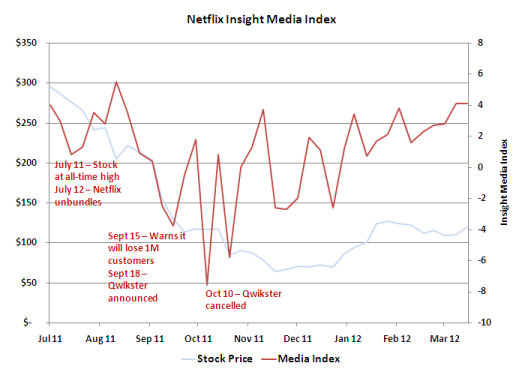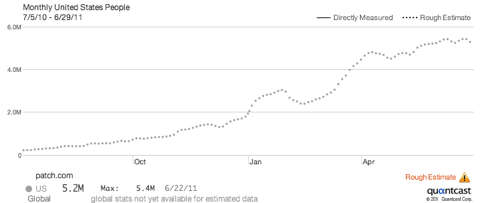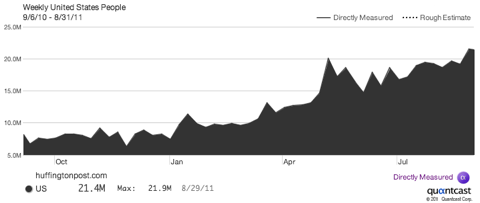Author: Barry Parr
Think twice before doubling down
This post originally appeared on Dow Jones’ blog The Conversational Corporation.
In the summer of 2011, Netflix was the future of video and its stock was at an all-time high. Within a quarter, the company lost two-thirds of its market value and its strategy was a shambles.
Between July and October 2011, the company unbundled its DVD and streaming services, increased its prices for the second time in a year, announced that it expected to lose a million customers and that it would spin off its DVD service under the brand “Qwikster”, and then canceled Qwikster less than a month later.
Netflix’s stock price has not recovered.
Netflix was trying to mitigate some powerful strategic threats in the summer of 2011, but the company lost control of its message.
I charted Netflix’s Dow Jones Insight Media Index (IMI) for 380,000 news stories since last July. Since October, Netflix’s IMI has returned to its summer 2011 levels, but the company’s stock price is stuck in the doldrums.
The Netflix debacle is more of a strategic than a communications fable, but there are some clear lessons for marketers:
• Think ahead. By delaying the inevitable unbundling until the last minute, Netflix maximized the pain for their customers and themselves.
• Keep it simple. Netflix was founded on a principle of simplicity, but Qwikster was just baffling.
• Own your name. Someone already owned @Qwikster on Twitter. This expensive error signaled a lack of preparation to the markets.
• Think twice before doubling down. Netflix followed its unpopular unbundling with a baffling spinoff.

I've moved to Chrome on the Mac
Although Chrome’s the best browser for Windows, I’ve favored Safari over Chrome on the Mac until a couple of weeks ago. Safari looks better and and is easier to use, in my opinion. But Chrome now works better.
I thought I was the only person experiencing the spinning beach ball when leaving lots of tabs and web apps open. I switched to Chrome on the Mac a couple of weeks ago, and there’s no question it performs far better for this purpose.
Tim Bray [via Gruber] notes the same solution:
In recent releases, Safari has been re-architected, with some of the work farmed out to a thing called “WebProcess”. This doesn’t seem to be working out that well. Specifically, I note that:
[…]
To be fair, part of the problem is the proliferation of Web apps that are extremely heavyweight in terms of the amount of JavaScript code sloshing around in the background. A notable example is Google+. Even sprucing up this blog’s typography has involved quite a bit of industrial-strength JavaScript. But that just seems to be what a modern Web browser has to suck it up and deal with.
Have we reached peak Patch?
Patch traffic and page growth appears to have flattened out. I’ve been following the rise of Patch traffic on Quantcast for about a year, and have been impressed with their steady linear growth. Until now.
Even accounting for summer doldrums, this looks like they’ve peaked.

Meanwhile, Huffington Post, a more mature AOL news property, grew at pretty healthy rate over of the summer, even ignoring the fact that Quantcast’s chart doesn’t start at zero.

I have mixed feelings about Patch. It is better than nothing — and nothing is what many communities were getting before Patch. But it doesn’t exactly break my heart to see this corporate competitor to hundreds of locally-owned community news sites hit its peak.
This week, Amazon.com dumped its California affiliates (including me) because it was unwilling to collect sales tax in the state.
I’d say it’s time for Amazon to grow up and be a good citizen, but that’s years overdue. Danny Sullivan has an excellent analysis of the issues, both economic and ethical.
There’s no question that Amazon is using what amounts to a loophole to gain unfair advantage over local retailers (not all of whom reside in big boxes).
I’ve been an Amazon affiliate for years, but never got around to posting the links on my community news site, mainly because I live in a small town, and I support my local retailers. I also buy a ton of stuff from Amazon, but I didn’t want to actively support the gutting of my downtown. To say nothing of the gutting of social services, state parks, schools, and quality of life resulting from the state’s tax drought.
I have no sympathy for all those affiliates chasing “passive” income. We’re seeing plenty of pro-Amazon of comments from those creepy libertarian nihilists. I do have a lot of sympathy for those affiliates who work hard to provide their readers with real value and are trying to make a go of it online. But they should be looking to Amazon for relief, not Sacramento.
I just saw a new attack on my member whitelist, in what may be a new wave in comment spam designed to attack sites that use member whitelists to control posting.
On Coastsider, my community news site, all commenters must verified before their comments are released and their accounts are taken off pre-moderation. This is relatively easy for me, since my service area is small and I ask new registrants for the name of the community they live in. That’s more work to fake than most comment spammers have time for. They don’t even try, usually using nonexistent places, such as “farm road” and “western trench”.
I verify most new members if they post a reasonable comment on a entry. Today I had a registration from a new user who left a comment that could have only been left by an informed local:
Tough to imagine the county of the present doing anything right in this part of Fitzgerald, where they can’t even locate the California Coastal Trail where it has already served well on an ad hoc basis for the last decade and a half.
No wonder: He lifted that comment from one of the informed locals who had already left a comment on that story.
I wouldn’t have figured that out if “Tom Smith” hadn’t also left a comment in Chinese on another story, and used the email address “[email protected]” and the real — but unlocal — community of “UK”.
I doubt SEOMimic is going to be as careless the next time it shows up on my site — or yours.
I get plenty of comment spammers on Coastsider, but this is the first attack of this nature I’ve seen. My guess is I’ll be seeing more — and more sophisticated — SEOMimic attacks in the future.
How did WordPress win over Movable Type? Majordomo has a good review of Six Apart’s strategic weaknesses and errors, and how WordPress/Automattic exploited each of them.
In my opinion, Six Apart’s biggest error was its choice of focusing on the enterprise market just as blogging was poised to go mainstream. This was an understandable mistake. They had investors to satisfy (not necessarily a bad thing) and there was no clear path to profitability for a software platform in the mass blogging market.
This lead directly to the Six Apart’s disastrous change in their license, which created WordPress’s moment of opportunity.
I was a happy Movable Type user at the time, but I was moving in other directions. I adopted Expression Engine for my next site, because MT didn’t have the membership management tools I needed. By the time I was ready to refocus my efforts on my MT site (MediaSavvy) in 2009, it was actually easier (by which I mean “possible”) to move it from an old version to MT to the latest WordPress than it was to upgrade to the latest version of Movable Type. Things had changed a lot in four years and the game was over.
The next time you justify a strategic decision by saying “That’s where money is”, you should remember that Willie Sutton was not a brilliant strategist.
Written in reply to a friend who asked for my thoughts on AOL/HuffPo.
My first thought on hearing this was “I hope they got cash, because I wouldn’t want to be a long-term investor in AOL.” Of course, they did.
I think HuffPo is a boring collection of gas-bag blogs. I was stunned by the price and startled when I looked them up on quantcast: They’re huge and growing fast, but page views per reader are declining.
So, long term, there are two kinds of content: the AOL/Yahoo/Demand Media/Rupert’s Daily dross, and the good stuff. The first type comes with a (problematic) business model. The second type has never been much of a business, but we continue to make it. Everything in the middle (me-too content not produced at scale) has no reason to exist.
Speaking as a competitor to Patch, I hope they continue using their cash to buy stuff.
Netflix is using an API, not to make their streaming services available to developers — which would cause all kinds of problems with their suppliers — and not for a handful of special projects.
Netflix has made their API a pillar of their multi-device distribution strategy. The other pillars are, suprisingly, HTML5 and Webkit (the open source Web browser engine). Instead of creating custom applications for each new device they want to be on, they’re porting Webkit to that device, if it’s not already there, and then building their custom application in HTML5.
The result, as I’m sure you know, is that Netflix is everywhere. Their customers can watch their movies on about 200 different devices. This video (from Mashery’s Business of API’s conference) changed the way I think about the impact of API’s on publisher strategy. I recommend watching starting at about 9 minutes into the video.
But their breadth of distribution is only one headline. The other headline is that they can rapidly change their appearance on all these devices quickly, with much less programming and a single platform: HTML + CSS + Javascript.
If Netflix can solve a distribution problem like this using standard Web technologies, publishers should reconsider non-standard solutions targeted at single platforms, such as iPads or iPhones. Right now, Apple is clearly dominant in non-PC distribution platforms, but we can expect rapid innovation from both hardware and software (Android, Windows, HP’s Palm, RIM, and more) manufacturers. Market fragmentation could become the norm in the near to mid term. And these new devices will be even better platforms for reading than for video.
Highly customized, device-specific “electronic magazines” and “digital newspapers” demo well and dominate the blog-driven news cycle, but they’re hardly the flexible platforms we’ll need in the next five years.
When mulitplatform distribution becomes the norm, we know that Netflix will be ready.
How many publishers will be ready?
